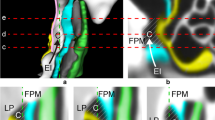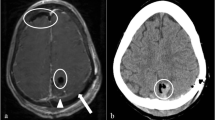Abstract
Post-traumatic orbital meningoencephaloceles related to orbital roof fractures are a challenging clinical entity because of their rarity and difficult differential diagnosis. We report a case of post-traumatic intra-orbital meningoencephalocele in a 69-year-old man, secondary to a likely trapdoor mechanism, treated with a modified one-piece orbitozygomatic craniotomy. We also performed an extensive literature review of traumatic Intra-Orbital Encephalocele related to Orbital Roof Fracture focused on adult patients on electronic databases including Scopus, MEDLINE/PubMed, and Google Scholar. Patient well recovered after surgery with immediate exophthalmos resolution and discharged without visual or neurological deficits. The literature review included 22 papers with a total of 28 patients: 22 males (78.6%) and 6 females (21.4%), with a median age of 34.7 years. Twenty-six patients (92.9%) reported ocular injuries, with associated intracranial complications in 16 cases (61.5%). Twenty-seven patients (96.4%) were surgically treated, 18 of those underwent unilateral or bilateral frontal approach. Most orbital roof fractures can be managed nanoperatively if asymptomatic. Indeed, when the intra-orbital volume decreases, for example due to an encephalocele, the intra-orbital pressure could increase and determine an orbital compartment syndrome. In our case, we performed a one-piece modified orbitozygomatic approach, which has several advantages in comparison to the frequent unilateral or bilateral frontal craniotomy like the better exposure of the brain and orbit and a minimum brain retraction.





Similar content being viewed by others
Data availability
The data that support the findings of this study are available from the corresponding author upon reasonable request.
Code availability
Not applicable.
References
Alsuhaibani AH, Hitchon PW, Smoker WRK, Lee AG, Nerad JA (2011) Orbital roof encephalocele mimicking a destructive neoplasm. Ophthal Plast Reconstr Surg 27(5):e121-123. https://doi.org/10.1097/IOP.0b013e318201cd6d
Anderson PJ, Poole MD (1995) Orbital floor fractures in young children. J Cranio-Maxillofac Surg 23(3):151–154. https://doi.org/10.1016/S1010-5182(05)80003-4
Antonelli V, Cremonini AM, Campobassi A, Pascarella R, Zofrea G, Servadei F (2002) Traumatic encephalocele related to orbital roof fractures: report of six cases and literature review. Surg Neurol 57(2):117–125. https://doi.org/10.1016/s0090-3019(01)00667-x
Burnstine MA (2003) Clinical recommendations for repair of orbital facial fractures. Curr Opin Ophthalmol 14(5):236–240. https://doi.org/10.1097/00055735-200310000-00002
Callahan N, Moles L (2021) Posterior occipital gunshot wound causing orbital roof blow-in fracture with encephalocele. Int J Oral Maxillofac Surg 50(12):1603–1605. https://doi.org/10.1016/j.ijom.2021.04.005
Chousterman B, Gualino V, Dohan A, Payen D (2014) A mysterious post-traumatic pulsatile exophthalmos. Intensive Care Med 40(1):102–103. https://doi.org/10.1007/s00134-013-3076-8
Connon FV, Austin SJB, Nastri AL (2015) Orbital roof fractures: a clinically based classification and treatment algorithm. Craniomaxillofac Trauma Reconstr 8(3):198–204. https://doi.org/10.1055/s-0034-1393728
Czyz CN, Strand AT (2016) Minimally invasive in vivo orbital pressure measurement. Clin Experiment Ophthalmol 44(8):724–725. https://doi.org/10.1111/ceo.12740
David DJ, Proudman TW (1989) Cephaloceles: classification, pathology, and management. World J Surg 13(4):349–357. https://doi.org/10.1007/BF01660747
Duhem-Tonnelle V, Duhem R, Mora AR, Allaoui M, Assaker R (2008) Encéphalocèle intraorbitaire post-traumatique chez un adulte : à propos d’un cas. Neurochirurgie 54:28–31. https://doi.org/10.1016/j.neuchi.2008.01.004
Lofrese G, Mongardi L, De Bonis P, Scerrati A, Nicassio N, Cultrera F (2020) Spontaneous repositioning of isolated blow-in orbital roof fracture: could wait and see be a strategy in asymptomatic cases? J Craniofac Surg. 31(3):e263–e266. https://doi.org/10.1097/SCS.0000000000006231
Gardner WJ (1948) Unilateral exophthalmos due to cerebellar tumor and orbital defect. J Neurosurg 5(5):500–502. https://doi.org/10.3171/jns.1948.5.5.0500
Gazioğlu N, Ulu MO, Ozlen F, Uzan M, Ciplak N (2008) Acute traumatic orbital encephalocele related to orbital roof fracture: reconstruction by using porous polyethylene. Ulus Travma Ve Acil Cerrahi Derg Turk J Trauma Emerg Surg TJTES 14(3):247–252
Ha AY, Mangham W, Frommer SA et al (2017) Interdisciplinary management of minimally displaced orbital roof fractures: delayed pulsatile exophthalmos and orbital encephalocele. Craniomaxillofacial Trauma Reconstr 10(1):11–15. https://doi.org/10.1055/s-0036-1584395
Hammer B (1995) Orbital fractures: diagnosis, operative treatment, secondary corrections. Hogrefe & Huber Publishers, Seattle
Jaiswal M, Sundar IV, Gandhi A, Purohit D, Mittal RS (2013) Acute traumatic orbital encephalocele: a case report with review of literature. J Neurosci Rural Pract 04(04):467–470. https://doi.org/10.4103/0976-3147.120209
Kim JW, Bae TH, Kim WS, Kim HK (2012) Early reconstruction of orbital oof fractures: clinical features and treatment outcomes. Arch Plast Surg 39(1):31. https://doi.org/10.5999/aps.2012.39.1.31
Koehler PJ, Blaauw G (1992) Late posttraumatic nonvascular pulsating eye. Acta Neurochir (Wien) 116(1):62–64. https://doi.org/10.1007/BF01541256
Kunz C, Audigé L, Cornelius CP, Buitrago-Téllez CH, Rudderman R, Prein J (2014) The comprehensive AOCMF classification system: orbital fractures - level 3 tutorial. Craniomaxillofac Trauma Reconstr 7(Suppl 1):S092-102. https://doi.org/10.1055/s-0034-1389562
Liao JC, Elmalem VI, Wells TS, Harris GJ (2015) Surgical timing and postoperative ocular motility in type B orbital blowout fractures. Ophthal Plast Reconstr Surg 31(1):29–33. https://doi.org/10.1097/IOP.0000000000000161
Luzzi S, Giotta Lucifero A, Spina A et al (2022) Cranio-orbito-zygomatic approach: core techniques for tailoring target exposure and surgical freedom. Brain Sci 12(3):405. https://doi.org/10.3390/brainsci12030405
Manfrè L, Nicoletti G, Lombardo M, Consoli V, Pero G, Albanese V (1993) Orbital, “blow-in” fracture: MRI. Neuroradiology 35(8):612–613. https://doi.org/10.1007/BF00588407
Messinger A, Radkowski MA, Greenwald MJ, Pensler JM (1989) Orbital roof fractures in the pediatric population. Plast Reconstr Surg. 84(2):213–216 (discussion 217-218)
Mokal NJ, Desai MF (2012) Titanium mesh reconstruction of orbital roof fracture with traumatic encephalocele: a case report and review of literature. Craniomaxillofacial Trauma Reconstr 5(1):11. https://doi.org/10.1055/s-0031-1300958
Morihara H, Zenke K, Shoda D, Fujiwara S, Suehiro S, Hatakeyama T (2010) Intraorbital encephalocele in an adult patient presenting with pulsatile exophthalmos Case report. Neurol Med Chir (Tokyo) 50(12):1126–1128. https://doi.org/10.2176/nmc.50.1126
Nakamura M, Struck M, Roser F, Vorkapic P, Samii M (2007) Olfactory groove meningiomas: clinical outcome and recurrence rates after tumor removal through the frontolateral and bifrontal approach. Neurosurgery. 60(5):844–852. https://doi.org/10.1227/01.NEU.0000255453.20602.80. (discussion 844-852)
O’Connor RC, Abazi S, Soleman J, Thieringer FM (2021) Reconstruction of a combined frontal bone and orbital roof defect with associated meningoencephalocele using 3D modeling and 3D navigation. Craniomaxillofacial Trauma Reconstr Open 6:24727512211023340. https://doi.org/10.1177/24727512211023340
Orbitozygomatic Craniotomy. Accessed June 3, 2022. https://www.neurosurgicalatlas.com/volumes/cranial-base-surgery/skull-base-exposures/orbitozygomatic-craniotomy
Page MJ, Moher D, Bossuyt PM, et al. PRISMA 2020 explanation and elaboration: updated guidance and exemplars for reporting systematic reviews. BMJ. Published online March 29, 2021:n160. doi:https://doi.org/10.1136/bmj.n160
Parameswaran A, Marimuthu M, Panwar S, Hammer B. Orbital fractures. In: Bonanthaya K, Panneerselvam E, Manuel S, Kumar VV, Rai A, eds. Oral and maxillofacial surgery for the clinician. Springer; 2021:1201–1250. doi:https://doi.org/10.1007/978-981-15-1346-6_57
Pereira RDS, da Silva JR, Guerra RC, Ferreira TV, Mota JM, Latini GL (2021) Management of an unusual blow-in orbital roof fracture associated an intracranial hematoma. J Craniofac Surg 32(1):e101–e102. https://doi.org/10.1097/SCS.0000000000006783
Phan L, Piluek W, McCulley T (2012) Orbital trapdoor fractures. Saudi J Ophthalmol Off J Saudi Ophthalmol Soc 26:277–282. https://doi.org/10.1016/j.sjopt.2012.05.008
Poe LB, Rosenbaum AE (1992) Transorbital herniation: an unusual mechanism of intracranial decompression following trauma. AJNR Am J Neuroradiol 13(1):231–233
Rev Med Liège 65 (2010).pdf. Accessed June 3, 2022. https://orbi.uliege.be/bitstream/2268/57013/1/Rev%20Med%20Li%C3%A8ge%2065%20%282010%29.pdf
Sadashivam S (2018) Isolated orbital roof fracture: can it be catastrophic? Asian J Neurosurg 13(3):935–937. https://doi.org/10.4103/ajns.AJNS_101_18
Sato O, Kamitani H, Kokunai T (1978) Blow-in fracture of both orbital roofs caused by shear strain to the skull Case report. J Neurosurg 49(5):734–738. https://doi.org/10.3171/jns.1978.49.5.0734
Sharma M, Mally R, Velho V, Agarwal V (2014) Spheno-orbital encephalocele: a rare entity – a case report and review of literature. Asian J Neurosurg 9(2):108. https://doi.org/10.4103/1793-5482.136728
di Somma L, Iacoangeli M, Nasi D et al (2016) Combined supra-transorbital keyhole approach for treatment of delayed intraorbital encephalocele: a minimally invasive approach for an unusual complication of decompressive craniectomy. Surg Neurol Int 7(Suppl 1):S12-16. https://doi.org/10.4103/2152-7806.173561
Stam LHM, Wolvius EB, Schubert W, Koudstaal MJ (2014) Natural course of orbital roof fractures. Craniomaxillofacial Trauma Reconstr 7(4):294–297. https://doi.org/10.1055/s-0034-1378188
Strandberg B (1949) Cephalocele of posterior part of orbit; general survey, with report of a case. Arch Ophthalmol Chic Ill. 1929 42(3):254–265. https://doi.org/10.1001/archopht.1949.00900050260004
Surgery of facial fractures. By Reed O. Dingman, A.B., D.D.S., M.S., M.D., and Paul Natvig, B.A., D.D.S., M.D. 10 × 7½ in. Pp. 380. Heavily illustrated, 1964. London: W. B. Saunders Ltd. £7 17s. 6d. BJS Br J Surg. 1964;51(7):560–560. doi:https://doi.org/10.1002/bjs.1800510741
Verbiest H (1953) Post-traumatic pulsating exophthalmos: caused by perforation of an eroded orbital roof by a hydrocephalic brain. J Neurosurg 10(3):264–271. https://doi.org/10.3171/jns.1953.10.3.0264
Voss JO, Hartwig S, Doll C, Hoffmeister B, Raguse JD, Adolphs N (2016) The, “tight orbit”: incidence and management of the orbital compartment syndrome. J Cranio-Maxillo-fac Surg Off Publ Eur Assoc Cranio-Maxillo-fac Surg 44(8):1008–1014. https://doi.org/10.1016/j.jcms.2016.05.015
Wilson L, Boase K, Nelson LD et al (2021) A manual for the Glasgow outcome scale-extended interview. J Neurotrauma 38(17):2435–2446. https://doi.org/10.1089/neu.2020.7527
You Y, Romero J, Diaz G, Herman J, Siu A, Evans R (2021) Cranial floor fracture: a growing orbital roof fracture with encephalocele – case report. Int J Surg Case Rep 78:172–175. https://doi.org/10.1016/j.ijscr.2020.12.012
Zhao D, Tao S, Zhang D, Qin M, Bao Y, Wu A (2018) “Five-layer gasket seal” watertight closure for reconstruction of the skull base in complex bilateral traumatic intraorbital meningoencephaloceles: a case report and literature review. Brain Inj 32(6):804–807. https://doi.org/10.1080/02699052.2018.1440631
Acknowledgements
The authors wish to thank the Scientific Bureau of the University of Catania for language support.
Author information
Authors and Affiliations
Contributions
Roberto Altieri conceived and planned the study. Giacomo Cammarata, Aurora Pizzo, and Angelo Basile did the literature retrieve. Giacomo Cammarata, Aurora Pizzo, and Angelo Basile applied selection criteria, extracted data, and evaluated study quality. Giacomo Cammarata synthesized the data and wrote the initial draft of the manuscript. All authors critically reviewed and revised the draft. All authors contributed to data result interpretation.
Corresponding author
Ethics declarations
Competing interests
The authors declare no competing interests.
Ethics approval
Not applicable.
Consent to participate
Written informed consent was obtained from the parents.
Consent for publication
The authors affirm that human research participant provided informed consent for publication of the images in Fig. 5A–D.
Conflicts of interest
The authors declare no competing interests.
Additional information
Publisher's note
Springer Nature remains neutral with regard to jurisdictional claims in published maps and institutional affiliations.
Rights and permissions
Springer Nature or its licensor (e.g. a society or other partner) holds exclusive rights to this article under a publishing agreement with the author(s) or other rightsholder(s); author self-archiving of the accepted manuscript version of this article is solely governed by the terms of such publishing agreement and applicable law.
About this article
Cite this article
Cammarata, G., Altieri, R., Certo, F. et al. Post-traumatic intra-orbital meningoencephalocele in adults: technical note on a rare entity and review of the literature. Neurosurg Rev 46, 6 (2023). https://doi.org/10.1007/s10143-022-01906-0
Published:
DOI: https://doi.org/10.1007/s10143-022-01906-0




